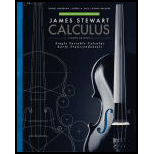
The point P(2, –1) lies on the curve y = 1/(1 – x).
(a) If Q is the point (x, 1/(1 – x)), use your calculator to find the slope of the secant line PQ (correct to six decimal places) for the following values of x :
(i) 1.5
(ii) 1.9
(iii) 1.99
(iv) 1.999
(v) 2.5
(vi) 2.1
(vii) 2.01
(viii) 2.001
(b) Using the results of part (a), guess the value of the slope of the tangent line to the curve at P(2, –1).
(c) Using the slope from part (b), find an equation of the tangent line to the curve at P(2, –1).
Want to see the full answer?
Check out a sample textbook solution
Chapter 2 Solutions
Student Solutions Manual for Stewart's Single Variable Calculus: Early Transcendentals, 8th (James Stewart Calculus)
Additional Math Textbook Solutions
Elementary Statistics: A Step By Step Approach
Graphical Approach To College Algebra
Calculus: Early Transcendentals (2nd Edition)
Beginning and Intermediate Algebra
Precalculus: A Unit Circle Approach (3rd Edition)
College Algebra (7th Edition)
- the correct answer is C could you please explainarrow_forwardWhich of the functions shown below is differentiable at z = 2? Select the correct answer below: о -7-6-5-4-3-2- −7 −6 −5 −4 −3-2 1 2 4 5 6 -7-6-5-4-3-2- -7-6-5-4-3 2 45arrow_forwardQuestion Given the graph of f(z) below, find the graph of the derivative of f(z). Select the correct answer below: ° ° 129 -7-6-5-4-3-2 -7-6-5-4-3-2-1123456 ° ° °arrow_forward
- Question Find the open interval(s) of f(x), graph given below, where f'(x) is negative. -3-2-1 1 2 4 5 6 Give your answer in interval notation. For example, (2, 4) U (6,∞). Provide your answer below:arrow_forwardthe correct answer is Ccould you please show me how to do it using the residue theoremarrow_forwardUse the information to find and compare Δy and dy. (Round your answers to four decimal places.) y = x4 + 7 x = −3 Δx = dx = 0.01 Δy = dy =arrow_forward
- Algebra & Trigonometry with Analytic GeometryAlgebraISBN:9781133382119Author:SwokowskiPublisher:Cengage
 Algebra and Trigonometry (MindTap Course List)AlgebraISBN:9781305071742Author:James Stewart, Lothar Redlin, Saleem WatsonPublisher:Cengage Learning
Algebra and Trigonometry (MindTap Course List)AlgebraISBN:9781305071742Author:James Stewart, Lothar Redlin, Saleem WatsonPublisher:Cengage Learning Trigonometry (MindTap Course List)TrigonometryISBN:9781337278461Author:Ron LarsonPublisher:Cengage Learning
Trigonometry (MindTap Course List)TrigonometryISBN:9781337278461Author:Ron LarsonPublisher:Cengage Learning  College AlgebraAlgebraISBN:9781305115545Author:James Stewart, Lothar Redlin, Saleem WatsonPublisher:Cengage Learning
College AlgebraAlgebraISBN:9781305115545Author:James Stewart, Lothar Redlin, Saleem WatsonPublisher:Cengage Learning Functions and Change: A Modeling Approach to Coll...AlgebraISBN:9781337111348Author:Bruce Crauder, Benny Evans, Alan NoellPublisher:Cengage Learning
Functions and Change: A Modeling Approach to Coll...AlgebraISBN:9781337111348Author:Bruce Crauder, Benny Evans, Alan NoellPublisher:Cengage Learning





